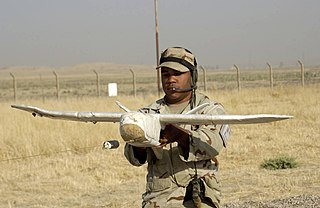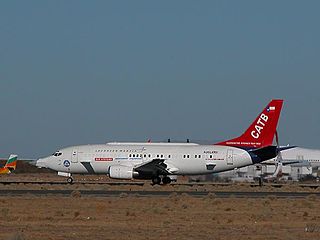
The RQ-3 DarkStar is an unmanned aerial vehicle (UAV). Its first flight was on March 29, 1996. The Department of Defense terminated DarkStar in January 1999, after determining the UAV was not aerodynamically stable and was not meeting cost and performance objectives.

The Northrop Grumman RQ-4 Global Hawk is a high-altitude, remotely-piloted surveillance aircraft introduced in 2001. It was initially designed by Ryan Aeronautical, and known as Tier II+ during development. The RQ-4 provides a broad overview and systematic surveillance using high-resolution synthetic aperture radar (SAR) and electro-optical/infrared (EO/IR) sensors with long loiter times over target areas.

The AAI RQ-7 Shadow is an American unmanned aerial vehicle (UAV) used by the United States Army, Australian Army, Swedish Army, Turkish Air Force and Italian Army for reconnaissance, surveillance, and target acquisition and battle damage assessment. Launched from a trailer-mounted pneumatic catapult, it is recovered with the aid of arresting gear similar to jets on an aircraft carrier. Its gimbal-mounted, digitally stabilized, liquid nitrogen-cooled electro-optical/infrared (EO/IR) camera relays video in real time via a C-band line-of-sight data link to the ground control station (GCS).

The Lockheed Martin Desert Hawk is a miniature UAV used for base perimeter protection. It was designed by Lockheed Martin's Skunk Works for the United States Air Force Force Protection Airborne Surveillance System (FPASS) Program on a quick-reaction contract issued late in the winter of 2002, with the first system delivered in the early summer. It was designed quickly, because the program leveraged technology and design studies developed for the MicroStar MAVs. The program was run by Electronic Systems Center. In 2007, the U.S. Air Force FPASS office switched all of their UAV systems over to the RQ-11B Raven.

The AeroVironment RQ-11 Raven is a small hand-launched remote-controlled unmanned aerial vehicle developed for the United States military, but now adopted by the military forces of many other countries.

The EADS Barracuda was a jet powered unmanned aerial vehicle (UAV), EADS, used for the role of aerial reconnaissance and also combat. The aircraft was a joint venture between Germany and Spain.

The Lockheed Martin CATBird is a highly modified Boeing 737-330 designed as an avionics flight testbed aircraft. The name is an adaptive acronym, from Cooperative Avionics Test Bed; CATBIRD is Lockheed's ICAO-designated company callsign. The aircraft was modified in order to provide an economic means of developing and flight testing the avionics suite for the Lockheed Martin F-35 Lightning II. CATBird has a distinctive appearance, with an F-35's nose and a pair of small canards located just aft of the forward entrance doors. Inside, the aircraft is equipped with racks to hold all of F-35's avionics, as well as an F-35 cockpit.

The BAE Systems Taranis is a British demonstrator programme for unmanned combat aerial vehicle (UCAV) technology, under development primarily by the defence contractor BAE Systems Military Air & Information. The aircraft, which is named after the Celtic god of thunder Taranis, first flew in 2013. An unmanned warplane, the Taranis is designed to fly intercontinental missions, and would carry a variety of weapons, enabling it to attack both aerial and ground targets. It uses stealth technology, giving it a low radar profile, and is controllable via satellite link from anywhere on Earth.

The Mitsubishi X-2 Shinshin is a Japanese experimental aircraft for testing advanced stealth fighter aircraft technologies. It is being developed by the Japanese Ministry of Defense Technical Research and Development Institute (TRDI) for research purposes. The main contractor of the project is Mitsubishi Heavy Industries. Many consider this aircraft to be Japan's first domestically made stealth fighter. ATD-X is an abbreviation for "Advanced Technology Demonstrator – X". The aircraft is widely known in Japan as Shinshin although the name itself is an early code name within the Japan Self-Defense Forces and is not officially in use. The aircraft's first flight was on 22 April 2016.

The BAE Systems HERTI is an unmanned aerial vehicle (UAV) developed by the British company BAE Systems. HERTI stands for "High Endurance Rapid Technology Insertion" and was developed in Warton, United Kingdom. The HERTI airframe is based on the J-6 Fregata motor glider designed by Jaroslaw Janowski of J&AS Aero Design in Poland. Its first flight was in December 2004 at the Australian Woomera test range where much of the test flight programme has been undertaken. HERTI was also the first UAV to fly in the UK with the flight being certified by the Civil Aviation Authority.
The BAE Systems Ampersand unmanned autonomous system (UAS) is an unmanned autogyro technology demonstrator, first announced at the 2008 Farnborough International Air Show. The Ampersand is based on the RotorSport UK MT-03 autogyro, with a sensor suite derived from the BAE Herti UAV. It is capable of being flown manned, for flight test purposes.

The Lockheed Martin RQ-170 Sentinel, nicknamed Wraith, is an American unmanned aerial vehicle (UAV) developed by Lockheed Martin and operated by the United States Air Force (USAF) for the Central Intelligence Agency (CIA). While the USAF has released few details on the UAV's design or capabilities, defense analysts believe that it is a stealth aircraft fitted with aerial reconnaissance equipment. Introduced in 2007, it was deployed to Afghanistan in late 2007, and to South Korea two years later, in September 2009. Some images and details of the aircraft were released after Iran captured an RQ-170 in 2011. It has a flying wing design, and uses a single engine, speculated to be either a General Electric TF34 turbofan or a Garrett TFE731.

The T-X program is a United States Air Force development and acquisition program for a new two-seat jet trainer to replace the Northrop T-38 Talon. On 27 September 2018, the US Air Force selected the Boeing/Saab T-X entry to become its trainer aircraft. The new aircraft was given the designation and name "T-7 Red Hawk" in September 2019. The Air Force's initial plan is to purchase 351 T-7s, and has an option to purchase up to 475.
The Lockheed Martin Sea Ghost was a proposal to fulfill the United States Navy's requirement for an Unmanned Carrier-Launched Airborne Surveillance and Strike aircraft.

The Lockheed Martin SR-72, colloquially referred to as "Son of Blackbird", is an American hypersonic UAV concept intended for intelligence, surveillance and reconnaissance (ISR) proposed privately in 2013 by Lockheed Martin as a successor to the retired Lockheed SR-71 Blackbird. In 2018, company executives said an SR-72 test vehicle could fly by 2025 and enter service in the 2030s.
The Northrop Grumman RQ-180 is an American stealth unmanned aerial vehicle (UAV) surveillance aircraft intended for contested airspace. As of 2019, there had been no images or statements released, but evidence points to the existence of the RQ-180 and its use in regular front-line service.
The Italian Armed Forces aircraft designation system is a unified designation system introduced by the Italian Armed Forces in 2009 for all Italian military aircraft. The system is based on the United States Armed Forces 1962 United States Tri-Service aircraft designation system.

The Airbus Sagitta from Airbus Defence and Space is a jet powered UAV research demonstrator, developed in cooperation with German research institutes as part of the Open Innovation initiative.

The Lockheed Martin X-44A is an unmanned aerial vehicle (UAV) technology demonstrator built by the Lockheed Martin Skunk Works.















